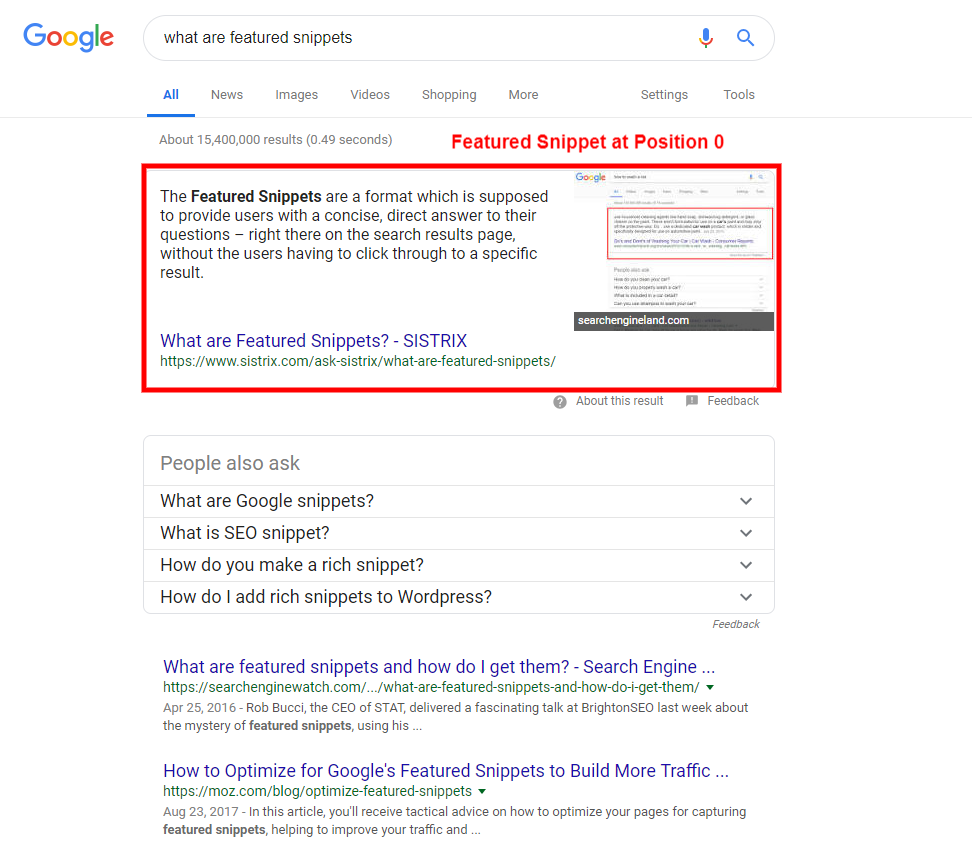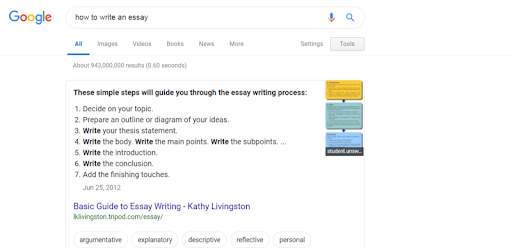Whether you call them featured snippets or position zero, they have become the holy grail of SEO since Google released this feature back in 2014. In short, featured snippets are direct, quick answers you’ll see at the very top of a Google search results page. The featured snippet block includes a direct answer to the user’s query. For instance, we searched “What are featured snippets?” and received the following:

The potential benefits of landing in position 0 on a search engine results page are tremendous. You stand to enjoy more traffic, more SERP visibility, and a significant jolt in the credibility of your brand. Fortunately, you don’t have to be in a top-ranking position to land in position 0.
Getstat reports a stunning 70% of featured snippets are from sites not currently in top-ranking organic positions. Let’s take a closer look at featured snippets and a few suggested ways you can increase your chances of landing in position 0.
What Are the Most Common Types of Featured Snippets?
Featured snippets can come in virtually all sizes and shapes, including:
- Numbered lists
- Paragraphs
- Tables
- Bulleted lists
- Images
- YouTube Videos
- Charts
According to Getstat, the most popular type of snippet is the “paragraph” type at 81.95%, list snippets came in at 10.77%, while table snippets came in at 7.28%. And when it comes to the types of queries receiving the most featured snippets, they include:
- Health
- DIY processes
- Mathematical
- Financial
- Status
- Requirements
- Transitional
How Can I Get a Featured Snippet?
No doubt, this is the million dollar question! The sobering answer is Google will decide which user’s queries will be most effectively answered by a featured snippet. At the same time, Google will decide which domains they’ll use for the answer.
Although you can tell Google to not use a page for a featured snippet — by including <meta name=“googlebot“ content=“nosnippet”> in the page header — there are no official markups that will make Google use your page. This also means you don’t need to have any type of special HTML markups for search engines to feature content from your site in position 0.
Claiming Position 0 Starts with Keyword Research
Most studies confirm featured snippets are regularly triggered by long-tail keywords, such as the “What are featured snippets?” query demonstrated above. As a matter of fact, the more words you type into the search box, the more likely you’ll be presented with a featured snippet. If you’re looking to land in position 0, start your keyword research with featured snippets in mind. Consider:
- You may find more success with long-tail question-type of queries. Look to answer one of the Five W’s — who, when, what, why, or where — of intermediate difficulty. It’s a good place to start because these are the easiest to identify, but you shouldn’t stop there.
- You should also target informational intent — not just questions. Although featured snippets usually look to answer a searcher’s immediate question, question-type queries are not the only kind that trigger featured snippets. According to an Ahrefs study, large majority of keywords that triggered featured snippets were long-tail queries without any questions in them.
Keep Your Sections Tight
If you want to land a featured snippet, it’s vital to keep the section concise and tight. One commonality we’ve noticed throughout most featured snippets is brevity. In addition, you should section off your paragraphs and lists instead of simply letting them run all together.

For example, this list is only 55 words. And SEMrush suggests it’s a relatively normal length for featured snippets. Their analysis discovered the most common length for featured snippet content is anywhere from 40-50 words.
However, it doesn’t mean your entire article should be a single paragraph. On the contrary, Google has consistently given preference to longer-format content, which is commonly referred to as cornerstone content. This content should be broken into smaller, more digestible subsections with attention-grabbing images.
Even if you do not believe longer-format cornerstone content receives preferential treatment in Google, you can still cover more related questions in a single piece by creating longer, more in-depth content. Here are a few tips that have delivered exceptional results for others:
- Ask questions in subheaders throughout the article. These subheaders should be closely related to the title.
- Once you ask the question, immediately answer it in a shorter one-paragraph answer.
- You can elaborate on the topic later on in the article.
Use Headers to Section off Your Content
In the process of formatting your content for featured snippets, it’s critical your break up content using SEO best practices. Make sure you organize your lists, steps, or paragraphs with headers in natural chronological order. You can use H1 headers, H2, H3, and H4 headers to organize your content and communicate the right message.
Keep It Well Organized and Factual
Similar to users, Google simply loves lists, steps, facts and numbers. You’ll see this time and time again, the information presented in featured snippets will be numbered lists, actual ingredients, cooking times, city of birth and birth years, as well as other fact based elements. Make sure to get as factual as possible and always employ numbers, lists, and proper names. Google seems to notice and like certain HTML codes, such as:
- <ol> Order Lists
- <table> Table
- <ul> Unordered list
Create a Single Article that Answers Several Related Question
Based on data from Ahrefs, once your page gets featured for particular information, it’s much more likely to be featured in other related queries. As a result, you should word your article and structure it in a manner that provides a lot of answers to several similar questions.
Google is exceptional at determining closely related questions and synonymic questions, which means there is no point in creating a new page to answer closely related questions. Having problems coming up with great questions? Use the Serpstat tool under “Questions” to help you create an awesome list of questions with your core keyword.
Got SEO questions? Don’t hesitate to contact Ready to Run for solutions and answers.




